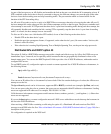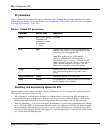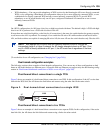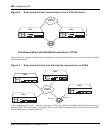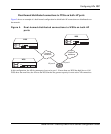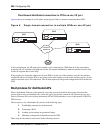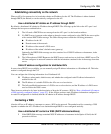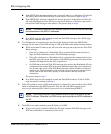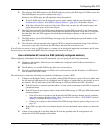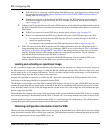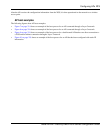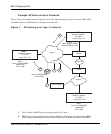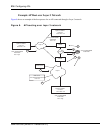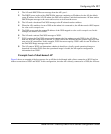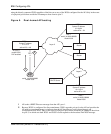
Configuring APs 211
Nortel WLAN—Security Switch 2300 Series Configuration Guide
5 The AP sends Find WSS requests to the WSS IP addresses given by the DNS reply. If a WSS receives the
Find WSS Request, the process continues with step 6.
However, if no WSSs reply, the AP repeatedly retries this method:
● If still no WSSs reply, the AP begins the process again, starting with the procedure under “How a
distributed AP contacts a WSS (DHCP-obtained address)” (page 209), on the other AP port.
● If the other AP port does not have a link or the AP has only one port, the AP instead restarts, and
begins the process again on the same AP port.
6 The WSS that receives the Find WSS request determines the best WSS for the AP to use, based on the
bias settings for the AP on each switch. If more than one switch has high bias for the AP or all switches
have the same bias, the WSS suggests the switch that has the highest capacity to add new active AP
connections.
7 The WSS sends a unicast Find WSS Reply message to the AP containing the system IP address of the
best WSS to use.
8 The AP sends a unicast message to the suggested WSS, to request an operational image. If the AP does
not receive a reply after 10 seconds, the AP reboots and starts the boot process over.
If an AP does not receive a reply to a DNS request or a request for an operational image after one minute, the AP starts
the boot process over with a new DHCP Discover message, this time from AP port 2.
How a distributed AP contacts a WSS (statically configured address)
When configuring a distributed AP with static IP information, you can specify the following information:
A IP address, subnet mask, default router, and whether the configured static IP address information is
enabled for the AP.
B The IP address of a suitable WSS for the AP to use as a boot device.
C The fully qualified domain name of a WSS to use as a boot device, and the IP address of a DNS server
used to resolve the WSS’s name.
This information is used in the following way when the AP attempts to contact a WSS:
1 If Items A and B (but not Item C) are specified, and the WSS’s IP address is part of the local subnet, then
the AP sends an ARP request for its configured static IP address, to ensure that it is not already in use in
the network. The AP then sends a Find WSS message to UDP port 5000 at the WSS’s IP address.
● If the AP receives a response from that address, it sends a unicast message to the WSS, to request an
operational image.
● If the AP does not get a response, then it sends a Find WSS message to UDP port 5000 on the subnet
broadcast address.
❍ If the AP receives a response to the broadcast Find WSS message, then the process continues
using the procedure described under “How a distributed AP contacts a WSS (DHCP-obtained
address)”, starting with step 6 on page 211.
❍ If there is no response to the broadcast Find WSS message, then the process skips to step 4 on
page 212.
● If the WSS is not part of the local subnet, then the AP uses the default router address to contact the
WSS.
2 If Item A, but not Item B is specified, then the AP uses the specified static IP configuration, and
broadcasts a Find WSS message to the subnet.



